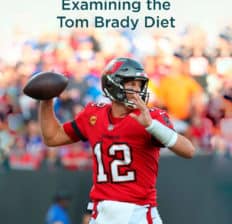This Dr. Axe content is medically reviewed or fact checked to ensure factually accurate information.
With strict editorial sourcing guidelines, we only link to academic research institutions, reputable media sites and, when research is available, medically peer-reviewed studies. Note that the numbers in parentheses (1, 2, etc.) are clickable links to these studies.
The information in our articles is NOT intended to replace a one-on-one relationship with a qualified health care professional and is not intended as medical advice.
This article is based on scientific evidence, written by experts and fact checked by our trained editorial staff. Note that the numbers in parentheses (1, 2, etc.) are clickable links to medically peer-reviewed studies.
Our team includes licensed nutritionists and dietitians, certified health education specialists, as well as certified strength and conditioning specialists, personal trainers and corrective exercise specialists. Our team aims to be not only thorough with its research, but also objective and unbiased.
The information in our articles is NOT intended to replace a one-on-one relationship with a qualified health care professional and is not intended as medical advice.
TB12 Method: How to Follow the Tom Brady Diet Plan
February 4, 2025

We all know Tom Brady as one of the best athletes in NFL history and current lead color commentator for Fox Sports, set to make his Super Bowl broadcasting debut when the Philadelphia Eagles take on the Kansas City Chiefs in Super Bowl LIX. He’s also become a top fitness influencer and even an authority on healthy eating, thanks to what’s been coined the “Tom Brady Diet,” also called TB12 or the TB12 method.
The retired seven-time Super Bowl champion quarterback followed this diet to stay in peak shape and perform at his best during his playing days, and he continues to tout the benefits of a healthy diet and exercise.
What does Tom Brady eat in a typical day? When he’s following the TB12 diet, his meals consist of nutrient-rich, anti-inflammatory foods, such as veggies, nuts, legumes and fruits.
What is the Tom Brady diet?
The Tom Brady diet, also called the TB12 diet, is an eating plan created by now retired American football player Tom Brady. It’s based on Brady’s method that he first detailed in 2017 in his book “The TB12 Method: How to Achieve a Lifetime of Sustained Peak Performance.”
It’s mostly plant-based, although not strictly vegetarian/vegan, and includes lots of whole foods, such as vegetables, fruits, whole grains, legumes, nuts and herbs.
Overall, it’s a high-fiber diet that is similar to the Mediterranean diet, DASH or MIND diet, “flexitarian diet,” alkaline diet, or anti-inflammatory diet. All of these plans are associated with a bunch of health perks, including protection against obesity, heart disease, diabetes and neurological issues.
How to follow the TB12 method
Does Tom Brady ever eat meat? Yes, although he tries to balance his meat consumption with plenty of plant foods.
You don’t have to strictly eat a plant-based diet to follow TB12, however you may need to cut back on your meat consumption. Brady suggests getting about 80% of your daily calories from plant foods and no more than 20% from meat, fish, eggs and other animal products.
The TB12 diet also excludes most processed foods and many packaged items, including sugary drinks, sweetened snacks and processed meats.
Aside from eating certain foods and avoiding others, TB12 sets some rules related to meal timing and food combining:
- Drink lots of water, but avoid drinks with calories and sugar.
- Avoid eating within three hours of going to sleep in order to help with digestion and metabolic health.
- Drink water 30 minutes before meals, and then avoid drinking water with meals and within one hour after eating.
- Eat fruit and foods high in carbohydrates alone, without lots of protein.
- Consider avoiding nightshade vegetables, such as white potatoes, tomatoes and eggplants, which may trigger allergies or reactions in some people.
He provides a few other tips as well, including:
- Focus on hydration, including drinking 20 ounces of water with added electrolytes first thing in the morning. This includes replenishing fluids and electrolytes while you exercise. Brady also recommends drinking at least half your body weight in ounces of water a day.
- Stop eating when you feel 75 percent full to encourage better nutrient absorption and digestion.
- Take a daily multivitamin to cover any potential nutritional shortfalls.
- Consumer a high-protein, high-calorie, high-fat pre-workout smoothie. (Brady reportedly loves to add chia or hemp seeds, along with walnuts and acai powder to his smoothies.)
- Drink a post-workout protein shake after exercising to enhance recovery.
Benefits
1. Can support heart and metabolic health
Like the Mediterranean diet, the Tom Brady diet can help to support cardiovascular health, as well as defend against type 2 diabetes. That’s because it’s high in fiber, antioxidants, vitamins, minerals and healthy fats, all of which defend against inflammation and oxidative stress.
For the most benefits, make sure to eat lots of different high-antioxidant, anti-aging and anti-inflammatory foods, such as leafy greens, berries, herbs, avocado, nuts, seeds, fish and olive oil.
Studies have shown that diets that include plenty of these foods can help normalize cholesterol, blood pressure and blood glucose levels.
2. Likely to be alkalizing and helpful for detoxification
Tom Brady is a big fan of an alkaline diet, which is a diet that helps balance the body’s pH level and boost resilience against toxins, inflammation and oxidative stress.
What types of foods are most alkalizing? Incorporate these alkaline foods into your diet to support digestion, immune function and liver health:
- cruciferous veggies, like kale and broccoli
- all types of greens, such as spinach and collard greens
- fruits, like oranges, pineapple, grapefruit and kiwi
- spices and herbs, such as turmeric, ginger, basil, cilantro, etc.
3. May help with weight loss
Because TB12 excludes high-calorie processed foods made with added sugar, oils and unhealthy fats, it can help people consume fewer calories overall and possibly lose weight.
Weight loss isn’t necessarily the main goal of the diet, but there’s a good chance you’ll maintain your weight more easily when eating mostly plant-based, whole foods and very little junk.
4. Can potentially support exercise performance and recovery
Brady believes that his high-quality diet played a big role in his ability to perform well and recover from tough workouts and draining football games.
As long as you incorporate enough protein foods in a TB12 diet plan, such as fish and legumes, you should be able to build and maintain lean muscle mass. By reducing your intake of inflammatory foods and boosting your vitamin and mineral consumption, you might have more energy and mental clarity when following TB12.
Risks and side effects
The TB12 diet is generally healthy and likely to lead to improvements in people’s nutrient intake if they switch to it from a “standard American diet.”
The main downside with the diet is that it’s somewhat restrictive and difficult to follow, considering it excludes gluten, most dairy and even some veggies.
If you eat a varied diet when following TB12 and make sure to include lots of different plant foods and sources of protein, then you probably won’t experience any side effects or nutrient deficiencies. That being said, it may be hard to follow the diet for more than a couple of months if you’re not willing to cook most of your meals at home.
In addition, the Tom Brady diet can be expensive, isn’t 100% supported by scientific evidence and may lead to a reliance on supplements to meet all your nutritional needs if you aren’t diligent on varying the foods you eat.
Foods to eat
The following foods are included in the Tom Brady diet:
- Most vegetables (except for nightshades)
- All types of fresh fruits
- Gluten-free whole grains, including quinoa, brown rice, buckwheat, oats, etc.
- Nuts and seeds
- Beans and legumes, such as chickpeas, peas, black beans, etc.
- Grass-fed meats and pasture-raised poultry, such as chicken, turkey and grass-fed steak
- Fish, especially oily fish like salmon and sardines
- Water as your main beverage, including water that has added electrolytes (such as potassium and magnesium)
- For most people, supplements are encouraged, including probiotics, whey protein powder and a daily multivitamin
Overall, you want to choose foods that meet this criteria:
- Whole foods that are minimally processed
- Ideally those that are organically grown
- If possible, seasonally and locally grown
- GMO-free
- Grass-fed, wild-caught and pasture-raised animal products
- Made without added sugar or oils
Foods to avoid
When following the Tom Brady diet, limit or avoid these foods and drinks:
- Sugary drinks, such as soda, juices, most sports drinks, etc.
- Packaged, processed foods, especially those containing sugar and trans fats, such as frozen meals, processed meats and cheeses, cakes, cookies, etc.
- Grains and foods with gluten, including all wheat products, most baked products and breads, barley, and rye
- Nightshades (see below)
- Most dairy products, other than whey protein
- Corn and soy products (such as soy sauce, high fructose corn syrup and corn flour)
- Caffeine (only a small amount is allowed)
- Alcohol (should be limited or avoided)
Why does Brady not eat tomatoes or certain other veggies?
TB12 encourages people to skip nightshade vegetables (plants in the Solanaceae plant family, such as tomatoes, eggplants, potatoes and peppers) because they can potentially cause reactions in some people who are sensitive to their effects.
However, while a small percentage of people don’t tolerate nightshades well, most people have no issues eating these healthy foods and can actually benefit from their antioxidants, fiber and other nutrients.
Sample shopping list and meal plan
Here’s what a menu may look like if you choose to try the Tom Brady diet:
Breakfast:
- Unsweetened oatmeal with flaxseeds, berries, cinnamon and almond butter.
- A smoothie made with whey protein, blueberries, banana, hemp seeds and almond milk
Lunch:
- Salad topped with cut-up veggies, chickpeas, sliced almonds, one hard-boiled egg and olive oil dressing
- Chicken tacos with veggies, avocado and salsa
Dinner:
- Fish, such as salmon, with cooked broccoli in garlic and oil, plus side of quinoa
- Stew made with veggies, beans and rice
Snacks:
- Fresh fruit, such as an apple, orange or banana
- Handful of trail mix
- Hummus with veggies
- Protein shake or bar
Sample shopping list:
- Rolled oats
- Flax, hemp and/or chia seeds
- Berries
- Cinnamon
- Almond butter
- Whey protein
- Bananas
- Oranges
- Apples
- Wild-caught salmon
- Greens, such as spinach
- Chickpeas
- Sliced almonds
- Pastured eggs
- Olive oil
- Pasture-raised chicken
- Avocado
- Salsa
- Broccoli
- Quinoa
- Carrots
- Celery
- Beans, such as kidney or white beans
- Brown rice
- Trail mix
- Walnuts
Conclusion
- The Tom Brady diet is a healthy eating plan that is about 80% plant-based.
- It’s a flexitarian diet, considering it includes some fish, eggs and meat, but emphasizes mostly fruit, vegetables, whole grains, nuts, seeds, beans and legumes.
- To follow the diet, avoid nightshade vegetables, processed foods with sugar and trans fats, and alcohol and caffeine.
- Benefits of this approach can include support for heart health, metabolic function, weight management, and exercise performance and recovery.





